|
Acoustic Ceiling Tile
Acoustic ceiling tile is the single most common source of glass fiber in indoor
office and school
environments in the US. Most sales people for acoustic ceiling tile are either
unaware of this fact
or are instructed to use other names for glass fiber in their product on the
assumption that the
change in name somehow changes the effects of exposure to the glass fiber. There
are about twenty
different names for glass fiber used by different manufacturers. Not all ceiling
tile contains glass
fiber. There are light tan colored cellulose fiber based acoustic tile and foam
acoustic tile that are
free of glass fiber.
Acoustic ceiling tile that contains glass fiber can be divided into two basic
groups by their gross
appearance. The body of the tile is either compact and gray or loose and yellow.
The gray tile
exhibits the greatest variability in composition, from nearly 90% glass fiber to
about 10% glass fiber.
The other materials in the body of the tile may include perolite, paper fiber,
clay, calcite, glass
shot, glass blebs, and asbestos. Glass fiber from acoustic ceiling tile is
identified by the other
materials still attached to it. Clear epoxy binder, sodium silicate, or similar
clear binder containing
small particles of calcite filler and binding the glass fiber to any of the
other possible materials
used to make these tiles identifies the glass as coming from acoustic ceiling
tile.
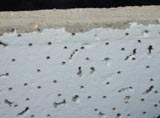


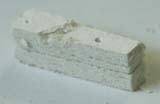
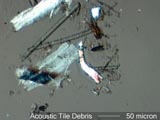
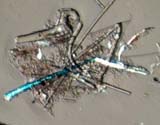
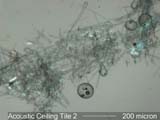
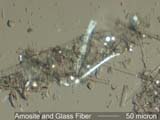
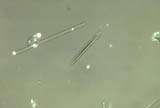
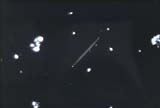
The yellow bodied acoustic ceiling tile that contains glass fiber is composed of
glass fiber and
yellow phenolic resin. The amount of resin and the amount of mineral filler used
in the resin varies
from one grade to another and from one manufacturer to another. Glass fiber from
yellow bodied
acoustic ceiling tile can often be distinguished from other yellow phenolic
bound glass fiber.
Yellow phenolic bound glass fiber from sound board in the HVAC system is
generally covered with
small impacted particles of natural minerals, soot, pollens and other airborne
particles. Yellow
phenolic bound glass fibers from blanket insulation typically contain much less
mineral filler in
the resin. Yellow phenolic bound glass fiber from cubicle divider panels tends
to contain much
more yellow resin than the yellow bodied acoustic ceiling tile. See the "Glass
Fiber" section of
the gallery for examples of all these materials.
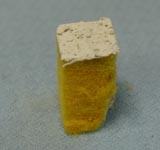
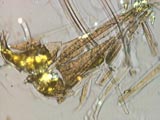
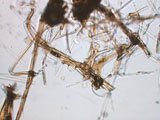
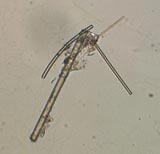

|